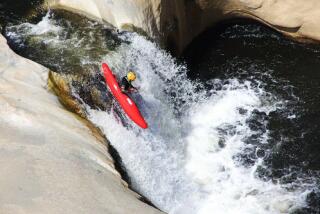Skydiver Savored Joy, Accepted Risk
- Share via
Susan Michele Spray understood the dangers of skydiving.
So much so that, before every jump, the 33-year-old aspiring writer from Huntington Beach left a note for her family in her bedroom that arranged her financial affairs -- even providing for the care of her cat, Daisy Mae -- in case the worst happened.
On March 5, as on many Saturdays, the novice skydiver leaped from a plane 12,500 feet over Perris Valley Skydiving in Riverside County.
It was her 55th jump, and her last.
Neither Spray’s primary nor backup parachute deployed. A friend jumping alongside noticed Spray struggling to open her chute.
She landed half a mile north of the Perris drop zone and died on impact.
“If I’d known she was going to die that day skydiving, I probably couldn’t have stopped her,” said Aidan Hampson, 37, Spray’s boyfriend of eight months.
Investigators at Perris Valley Skydiving are still trying to determine what went wrong. Riverside County sheriff’s officials determined that Spray’s death was an accident, although they are awaiting autopsy results.
To her family’s surprise, the quiet, thoughtful Spray had thrown herself into skydiving about 18 months ago and graduated from the jump school at Perris, one of the nation’s largest skydiving centers. The sport helped draw Spray, who was finishing her master’s degree in technical writing at Cal State Long Beach, out of her shell, family and friends say.
“I really noticed a different Michele” after she started skydiving, said Spray’s half-brother, Duane Wehus. “She was more talkative -- just happy.”
Hampson also described Spray as “over the moon” about finally landing her dream job.
The day before she died, Spray and Hampson celebrated her new post as a technical writer for a heart catheter company.
Spray’s death highlights the inherent risks of a sport many embrace for the adrenaline rush.
Skydivers cultivate an intimate knowledge of their gear and learn to manipulate their bodies so they can plunge through the sky with confidence. After Spray’s death, master riggers at Perris Valley Skydiving examined both chutes and found nothing wrong; Spray had completed one jump that day.
“We try to check out everything we can to see if there’s ... anything that we possibly could have done to prevent this, and everything was fine,” said Dan Brodsky-Chenfeld, general manager of the facility, where there are 150,000 jumps each year.
“It disturbs people when all of a sudden you’re faced with the reality that you’re jumping out of an airplane. It’s a very, very dangerous sport,” Brodsky-Chenfeld said. “We lose sight of that.”
Perris Valley experts are examining Spray’s CYPRES, or Cybernetic Parachute Release System, a device designed to automatically deploy a diver’s backup chute at a preset altitude. Brodsky-Chenfeld said it was possible that Spray could have programmed her CYPRES at home, near sea level in Huntington Beach, rather than at Perris’ 1,500-foot elevation, throwing off the altitude settings.
“I want to know what the heck went wrong,” Wehus said.
Skydiving safety has been steadily improving with more technologically advanced gear, but accidents persist.
The 25 skydiving fatalities nationwide last year were below the decade-long yearly average of 31, according to the United States Parachute Assn.
“We have more people doing it and fewer people dying, so we’re doing something right,” said Chris Needels, executive director of the Alexandria, Va.-based organization of 34,000 members. Although skydiving newcomers must take courses on how to jump, , after graduation, jumpers are essentially responsible for their own equipment and safety. A handful of those deaths occur annually in California, Nevada, Arizona and Hawaii combined, said Donn Walker, spokesman for the Federal Aviation Administration’s Western-Pacific Region. The FAA regulates the procedures that pilots carrying skydivers must follow, and how to pack a parachute correctly. A skydiver packs his or her own main chute. Backup chutes must be repacked by a licensed expert every 120 days whether they’ve been deployed or not, Brodsky-Chenfeld said.
“Being safe is not that difficult; you just can’t be complacent about it,” he said. A death at the drop zone stirs the sympathy of Perris Valley skydivers, but does not keep them grounded.
“You feel sad; it’s a fellow skydiver,” said Michael Kelly, 57, an electrical contractor visiting from Derby, England. “We know the risks ... accidents do happen, things happen. It’s that kind of sport.”
Strangely, Spray’s aunt and uncle were near the site where she died. The couple, headed to a birthday party in Nuevo, had stopped for directions at a Riverside County trucking company and heard someone hitting the ground about 100 feet away, Wehus said. Rattled, they knew it was a skydiver, but didn’t learn until later it was their niece.
Spray’s father, Hobert, was never comfortable with her jumping. But Wehus, 47, recalls a sister who’d opened up to him in the last few years, joining him for rafting trips on the Kern River and family poker nights that eroded the age barrier that had kept them at arm’s length.
Spray had “her whole life ahead of her,” Wehus said, describing how she had brought cookies to their mother, Belen, confined to a nursing home, every weekend before she died more than a decade ago. Wehus plans to plant an orange tree at his home in Murietta, burying some of Spray’s ashes at the roots. “She’ll always be my little sister,” he said.
Parachute packer Jennifer Drew, 29, rolling the giant, colorful canopies into tight bundles at Perris Valley, sees in Spray’s death her zest for life.
“If anything bad happens, that person was doing something they really, really loved,” Drew said. “In a weird way, that’s probably one of the best ways to go.”
More to Read
Sign up for Essential California
The most important California stories and recommendations in your inbox every morning.
You may occasionally receive promotional content from the Los Angeles Times.













